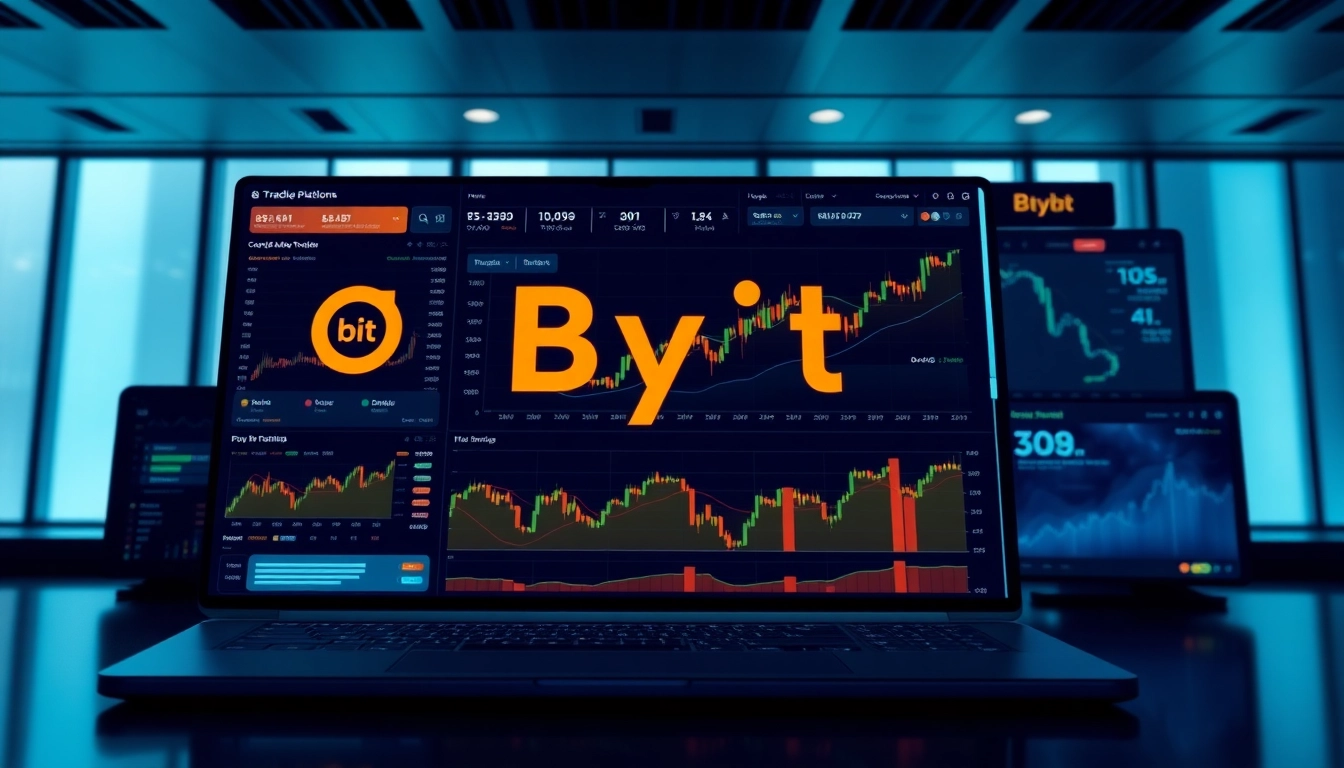Introduction to Bybit and Crypto Trading Fundamentals
Cryptocurrency trading has surged in popularity over the past few years, transforming from niche investment activity to mainstream financial engagement. As the market evolves amid increasing regulatory clarity, platforms like Bybit crypto tutorial have become essential tools for traders seeking reliable, user-friendly environments to execute their strategies. Understanding the core concepts of crypto trading and how to navigate platforms like Bybit is crucial for both beginners and experienced traders aiming to optimize their profits and manage risks effectively.
What is Bybit and Why Use It for Crypto Trading?
Founded in 2018, Bybit has quickly established itself as a top-tier cryptocurrency derivatives exchange, primarily catering to a global user base with advanced trading features, competitive fees, and robust security measures. Unlike traditional exchanges that focus solely on spot trading, Bybit specializes in derivatives, offering perpetual contracts and options that enable traders to leverage their positions.
One of the main reasons to choose Bybit is its intuitive interface coupled with sophisticated tools that appeal to both novice traders and professional strategists. Additionally, Bybit’s high liquidity, leveraged trading options up to 100x, and strong emphasis on risk management make it a preferred platform for those looking to maximize gains in volatile markets. Its recent compliance with regulatory standards in regions like the European Union further emphasizes its reliability and commitment to transparent operations.
Understanding the Basics of Cryptocurrency Markets
Before diving into platform-specific tutorials, it’s vital to grasp the fundamental mechanics of the cryptocurrency markets. Digital assets like Bitcoin, Ethereum, and numerous altcoins are traded across various exchanges, with prices driven by supply and demand, macroeconomic factors, technological developments, and sentiment analysis.
Crypto markets operate 24/7, unlike traditional financial markets, demanding active monitoring and quick decision-making. Market participants include retail investors, institutional traders, and algorithmic trading systems, all contributing to a dynamic environment characterized by high volatility but also significant profit opportunities. Understanding concepts like order books, bid-ask spreads, and liquidity pools is essential for effective trading.
Setting Up Your Bybit Account Safely
Creating a secure and efficient account on Bybit involves several key steps. First, visit the official Bybit guide to familiarize yourself with registration procedures. You will need to verify your email address and set up two-factor authentication (2FA) to safeguard your account from unauthorized access.
Next, complete your profile verification by submitting identity documents, which enhances your account’s credibility and unlocks higher withdrawal limits. Always ensure you use a strong, unique password and enable security features such as anti-phishing codes. Selecting a secure device and avoiding public Wi-Fi minimizes risks related to hacking or account breaches.
Step-by-Step Guide to Using the Bybit Crypto Platform
Depositing Funds and Navigating the Dashboard
After registration and verification, depositing funds onto Bybit is straightforward. Navigate to the “Assets” tab and select “Deposit.” Choose your preferred cryptocurrency, such as USDT or BTC, and generate a deposit address. Send your crypto from an external wallet or exchange to this address. Always double-check the address and transaction details to avoid errors.
The Bybit dashboard provides real-time market data, open positions, order history, and account balances. Familiarize yourself with menus like “Trade,” “Derivatives,” and “Assets” to efficiently access trading pairs and manage your holdings.
Executing Your First Trade: Buy and Sell Cryptos
To execute a trade, go to the “Trade” section, select the trading pair (e.g., BTC/USD), and choose between spot trading or derivatives trading depending on your strategy. For beginners, starting with spot trading allows buying and selling cryptocurrencies at current market prices with no leverage. Experienced traders may explore perpetual contracts leveraging their positions for amplified gains.
Set your order type—market order for immediate execution or limit order to specify the price point. Confirm the order details, including quantity and price, then execute. Monitoring your open positions and order status directly from the platform is crucial for timely decision-making.
Advanced Trading Features and Tools on Bybit
Bybit offers various advanced features like margin trading, stop-loss and take-profit orders, and leverage management. The platform also provides sophisticated charting tools, technical indicators, and API integrations for algorithmic trading. Utilizing these tools effectively can significantly enhance your trading strategies.
Demo trading modes and educational resources allow users to practice and refine tactics without risking real money. Regularly exploring new features and updates keeps traders competitive in the fast-paced crypto environment.
Strategies to Maximize Your Gains with Bybit
Spot Trading vs. Derivatives Trading Explained
Spot trading involves buying and selling actual cryptocurrencies, making it suitable for long-term investors or those new to crypto. Conversely, derivatives trading on platforms like Bybit allows traders to speculate on price movements without owning the underlying asset, often using leverage to increase potential returns.
While derivatives offer higher profit margins, they also entail increased risks, including liquidation and margin calls. Understanding the nuances of both trading types helps traders choose strategies aligned with their risk tolerance and market outlook.
Risk Management and Utilizing Stop-Loss Orders
Implementing prudent risk management is vital in volatile markets. Stop-loss orders automatically close positions when prices reach predetermined levels, limiting potential losses. For example, setting a stop-loss 5% below your entry point ensures you exit before losses grow uncontrollably.
Consistently applying risk management principles, maintaining a diversified portfolio, and avoiding over-leverage are best practices to sustain long-term profitability.
Leveraging Technical Analysis for Better Results
Technical analysis involves studying price charts, volume patterns, and technical indicators like Moving Averages, RSI, MACD, and Bollinger Bands to forecast future price movements. Mastering these tools aids traders in identifying entry and exit points, trend reversals, and breakout signals.
Platforms like Bybit integrate advanced charting features, making it easier for traders to perform technical analysis efficiently. Combining technical insights with fundamental news assessments enhances decision-making accuracy.
Common Challenges and Troubleshooting
How to Handle Account Security and Authentication
Security breaches are a significant concern in crypto trading. Beyond basic measures like strong passwords and 2FA, traders should regularly review account activity logs, enable anti-phishing codes, and be vigilant against phishing scams. Using hardware wallets for large holdings adds an extra security layer.
Addressing Transaction Delays and Errors
Transaction delays can occur due to network congestion or incorrect deposit addresses. Always verify the address before sending crypto and monitor network statuses. If delays happen, check blockchain explorers for transaction confirmations and contact support if needed. Maintaining patience during high traffic periods is essential.
Where to Find Support and Resources
Bybit offers a comprehensive Help Center, live chat support, and an active community forum. Continuous education through webinars, tutorials, and newsletters helps traders stay updated on platform features and market trends.
Measuring Success and Continuing Education
Tracking Your Trading Performance
Maintaining detailed trading logs and using analytical tools allows you to evaluate your strategies’ effectiveness. Key metrics include win-loss ratio, average ROI, and maximum drawdown. Regular review helps identify areas for improvement.
Keeping Up with Market Trends and News
Crypto markets are influenced by macroeconomic developments, regulatory updates, and technological advancements. Subscribing to authoritative news outlets, participating in community discussions, and attending webinars ensure you remain well-informed.
Further Learning: Advanced Strategy Resources
To advance beyond basics, explore courses on technical analysis, algorithmic trading, and DeFi applications. Platforms like Coin Medium provide insightful articles and expert analysis to elevate your trading acumen.



